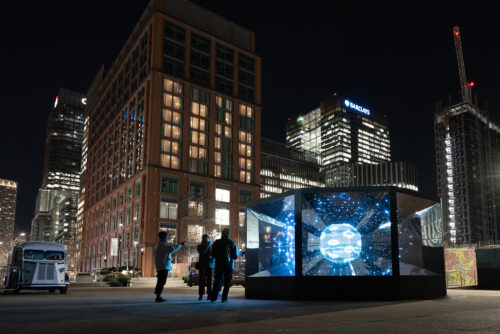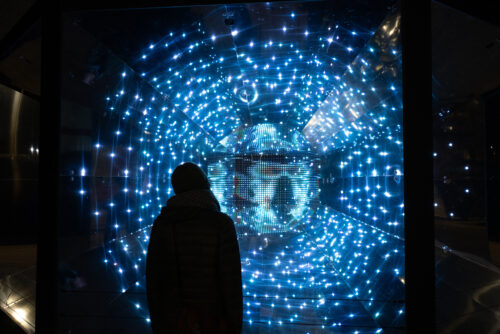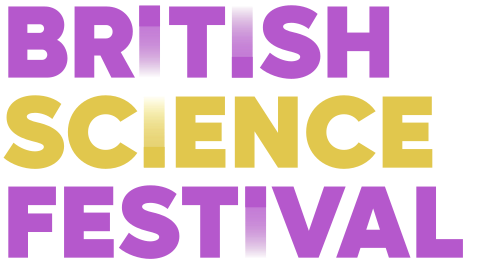The British Science Festival and Culture Liverpool will be showing ‘Geist’ by This is Loop (artists Harriet Lumby and Alan Hayes) in the centre of Liverpool at Liverpool ONE from the 10 – 14 September.

As part of the celebration of the scientific culture and innovation taking place across the Liverpool City Region, they’re turning the spotlight on one of the most mysterious building blocks of our universe – neutrinos.
Also known as ‘ghost-particles’, neutrinos are the most abundant massive particles in the universe and are extremely hard to detect. One of the many mysteries surrounding neutrinos is that the three different types of neutrinos can change into each other.
Geist is a large-scale sculpture which offers a window into a figment of reflection and light, created by a mirror illusion and showing a suspended illuminated orb. The illusion is interactive; only by the proximity and movement of the audience, does the suspended particle of light come to life. Individually addressable LED modules start flickering and glimmering in the presence of people.
The public are the cause of the artwork’s existence, their interactions creating a response from the artwork; a version of the ‘hide and seek’ played out in a neutrino detector where only an interaction with an atom reveals the neutrino.
Geist includes real data from neutrino experiments in collaboration with the UK’s Science and Facilities Technology Council (STFC). STFC have major research and innovation campuses across the UK, including at Daresbury in the Liverpool City Region.
To delve deeper into the world of particle physics, some of the world’s leading particle physicists will discuss how we are starting to understand more about the fundamental building blocks of the universe.
Join, Graziano Venanzoni (University of Liverpool), Saskia Charity (University of Liverpool), Mark Thomson (CERN) and Jocelyn Monroe (University of Oxford) to find out about fascinating particle physics projects including the Muon g-2 experiment, the Darkside-20k experiment, and the Large Hadron Collider.
Researchers from the Department of Physics (University of Liverpool) will also showcase real particle detectors, demonstrate how they work and explain how experiments are designed.
People can also join an interactive virtual tour of Boulby Underground Laboratory in Yorkshire, where scientists are searching for the elusive ‘dark matter’ that makes up most of the mass of the universe.

Claire McColgan CBE, Liverpool’s Director of Culture and Associate Director of Culture for Liverpool City Region said: “We are delighted that Liverpool is hosting this amazing crossover of science and culture in the heart of the city, giving people a rare chance to see a hidden but vital part of our universe.
“This project is such an innovative and artful way to make science accessible. We are looking forward to seeing how it sparks intrigue among our many visitors and residents and highlights some of the brilliant innovation happening in the city.”
James Brown, Director of the British Science Festival said: “We’re so pleased to be able to showcase the world leading science and innovation taking place across the Liverpool City Region, including research into the very building blocks of our universe! Geist brings together art and science in a way that lets us experience and explore this incredible phenomenon which is happening all around us – even if we can’t detect it!”
Donna Howitt, Place Strategy Director at Liverpool ONE said: “We are looking forward to welcoming the British Science Festival to Liverpool. Science, just like fashion, sport and music, is part of the city’s identity, and it’s fantastic to see such an ambitious, diverse programme come to life right across the city.
“At Liverpool ONE, we’re passionate about supporting events that spark curiosity and bring communities together. We are proud to play our part in showcasing the city on a national stage and help to inspire the next generation of scientists, researchers and engineers.”
Further details
The scientific narrative of Geist has involved input from particle physicists at the Rutherford Appleton Laboratory, part of the Science and Technology Facilities Council, and the Physics Department at Oxford University.
The collected group of physicists have provided access to and context for real neutrino oscillation measurements from the T2K neutrino experiment in Japan. In collaboration with new-media artist Motus Art sound artist Dan Bibby, This is Loop have re-interpreted actual neutrino interactions seen by T2K, using input from motion sensor cameras and complex code, into the animation of moving light and audio for Geist. The type of ‘neutrino’ seen will depend on the neutrino oscillation probabilities from T2K. When the audience interacts with the sculpture, Geist will reflect a visual and audio representation of the detection of a neutrino.
This is Loop are an award-winning, Somerset based creative studio, led by Harriet Lumby and Alan Hayes, that make and tour original audio-visual artworks around the world; seeing audiences upwards of 1.5million in the last couple of years alone. Their acclaimed sculptural artwork plays with reflection, moving light and illusion and sits at the intersection of art, science and technology.
